Services

The Treasury at Petra - Jordan's most popular attraction.

The giant red mountains and vast mausoleums of a departed race have nothing in common with modern civilization, and ask nothing of it except to be appreciated at their true value - as one of the greatest wonders ever wrought by Nature and Man.
Although much has been written about Petra, nothing really prepares you for this amazing place. It has to be seen to be believed.
Often described as the eighth wonder of the ancient world, is without a doubt Jordan's most valuable treasure and greatest tourist attraction. It is a vast, unique city, carved into the sheer rock face by the Nabataeans, an industrious Arab people who settled here more than 2000 years ago, turning it into an important junction for the silk, spice and other trade routes that linked China, India and southern Arabia with Egypt, Syria, Greece and Rome.
Amman - a modern city built on the sandas of time

Amman, the capital of Jordan, is a fascinating city of contrasts – a unique blend of old and new, ideally situated on a hilly area between the desert and the fertile Jordan Valley./p>
In the commercial heart of the city, ultra-modern buildings, hotels, smart restaurants, art galleries and boutiques rub shoulders comfortably with traditional coffee shops and tiny artisans' workshops. Everywhere there is evidence of the city's much older past.
Due to the city's modern-day prosperity and temperate climate, almost half of Jordan's population is concentrated in the Amman area. The residential suburbs consist of mainly tree-lined streets and avenues flanked by elegant, almost uniformly white houses in accordance with a municipal law, which states that all buildings must be faced with local stone.
Azraq - an oasis of natural beauty and tranquility
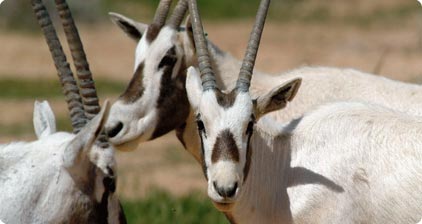
Azraq is a unique wetland oasis located in the heart of the semi-arid Jordanian eastern desert, one of several beautiful nature reserves managed by the RSCN. Its attractions include several natural and ancient-built pools, a seasonally flooded marshland, and a large mudflat known as Qa'a Al-Azraq. A wide variety of birds stop at the reserve each year to rest during their arduous migration routes between Asia and Africa. Some stay for the winter or breed within the protected areas of the wetland.
The best time to visit Al-Azraq is in late autumn, winter or spring. Winter rains often create pools and marshes over the reserve, which continue to attract many seasonal species of birds. The success of bird-watching visits depends largely on the amount of water that has accumulated in the reserve.
Azraq has an interesting geological history. It was once a vast oasis, its pools filled by a complex network of aquifers fed mainly from the Jebel Druze area of southern Syria – the waters taking up to 50 years en route. Surrounding the oasis is about 60 sq.m. of silt, beneath which is a vast concentration of salt.
Deadsea - Nature's living miracle, a place to rejuvenate and restire both body and soul
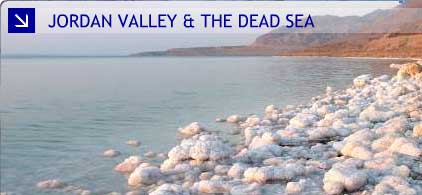
Without a doubt the world's most amazing place, the Jordan Rift Valley is a dramatic, beautiful landscape, which at the Dead Sea, is over 400m (1,312 ft.) below sea level. The lowest point on the face of the earth, this vast, stretch of water receives a number of incoming rivers, including the River Jordan. Once the waters reach the Dead Sea they are land-locked and have nowhere to go, so they evaporate, leaving behind a dense, rich, cocktail of salts and minerals that supply industry, agriculture and medicine with some of its finest products.
The Dead Sea is flanked by mountains to the east and the rolling hills of Jerusalem to the west, giving it an almost other-worldly beauty. Although sparsely populated and serenely quiet now, the area is believed to have been home to five Biblical cities: Sodom, Gomorrah, Adman, Zebouin and Zoar (Bela).
One of the most spectacular natural and spiritual landscapes in the world, the Jordanian east coast of the Dead Sea has evolved into a major hub of both religious and health & wellness tourism in the region. A series of good roads, excellent hotels with spa and fitness facilities, as well as archaeological and spiritual discoveries make this region as enticing to today's international visitors as it was to kings, emperors, traders, prophets and pilgrims in antiquity.
Karak

Whether you approach Karak from the ancient Kings Highway to the east or from the Dead Sea to the west, the striking silhouette of this fortified town and castle will instantly make you understand why the fates of kings and nations were decided here for millennia.
An ancient Crusader stronghold, Karak sits 900m above sea level and lies inside the walls of the old city. The city today is home to around 170,000 people and continues to boast a number of restored 19th century Ottoman buildings, restaurants, places to stay, and the like. But it is undoubtedly Karak Castle that dominates.
The town is built on a triangular plateau, with the castle at its narrow southern tip. The castle is some 220m long, 125m wide at the north end, and 40m wide at the southern end where a narrow valley deepened by a ditch separates it from the adjoining and much higher hill – once Saladin's favourite artillery position. Throughout the castle, dark and roughly-shaped Crusader masonry is easy to discern from the finely-crafted blocks of lighter and softer limestone used in later Arab work.
Wadi
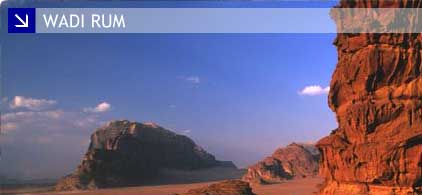
This is a stupendous, timeless place, virtually untouched by humanity and its destructive forces. Here, it is the weather and winds that have carved the imposing, towering skyscrapers, so elegantly described by T.E. Lawrence as "vast, echoing and God-like..."
A maze of monolithic rockscapes rise up from the desert floor to heights of 1,750m creating a natural challenge for serious mountaineers. Hikers can enjoy the tranquility of the boundless empty spaces and explore the canyons and water holes to discover 4000-year-old rock drawings and the many other spectacular treasures this vast wilderness holds in store.
Also known as 'The Valley of the Moon', this is the place where Prince Faisal Bin Hussein and T.E. Lawrence based their headquarters during the Arab Revolt against the Ottomans in World War I, their exploits intrinsically woven into the history of this amazing area.
Aqaba

With its wealth of other attractions, Jordan's splendid Red Sea resort is often overlooked by modern-day visitors. But apart from being a delightful place for discerning holidaymakers, this is actually a great base from which to explore various places of interest in southern Jordan.
Aqaba is a fun place. It is a microcosm of all the good things Jordan has to offer, including a fascinating history with some outstanding sites, excellent hotels and activities, superb visitor facilities, good shopping, and welcoming, friendly people, who enjoy nothing more than making sure their visitors have a good time.
But perhaps Aqaba's greatest asset is the Red Sea itself. Here you can experience some of the best snorkelling and diving in the world. The temperate climate and gentle water currents have created a perfect environment for the growth of corals and a teeming plethora of marine life. Here you can swim with friendly sea turtles and dolphins as they dart amongst the schools of multi-coloured fish. Night dives reveal the nocturnal sea creatures, crabs, lobsters and shrimp, as they search for a midnight snack.
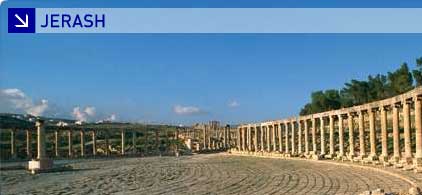
Jerash
img_column_mask.jpgA close second to Petra on the list of favourite destinations in Jordan is the ancient city of Jerash, which boasts an unbroken chain of human occupation dating back more than 6,500 years.
Jerash lies on a plain surrounded by hilly wooded areas and fertile basins. Conquered by General Pompey in 63 BC, it came under Roman rule and was one of the ten great Roman cities of the Decapolis League.
The city's golden age came under Roman rule, during which time it was known as Gerasa, and the site is now generally acknowledged to be one of the best-preserved Roman provincial towns in the world. Hidden for centuries in sand before being excavated and restored over the past 70 years, Jerash reveals a fine example of the grand, formal provincial Roman urbanism that is found throughout the Middle East, comprising paved and colonnaded streets, soaring hilltop temples, handsome theatres, spacious public squares and plazas, baths, fountains and city walls pierced by towers and gates.
Ajlun
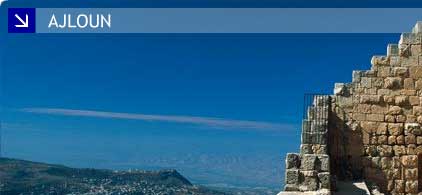
The marvels of nature and the genius of medieval Arab military architecture have given northern Jordan two of the most important ecological and historical attractions in the Middle East: the sprawling pine forests of the Ajlun-Dibbine area, and the towering Ayyubid castle at Ajlun, which helped to defeat the Crusaders eight centuries ago.
Ajlun Castle (Qal'at Ar-Rabad) was built by one of Saladin's generals in 1184 AD to control the iron mines of Ajlun, and to deter the Franks from invading Ajlun. Ajlun Castle dominated the three main routes leading to the Jordan Valley and protected the trade and commercial routes between Jordan and Syria; it became an important link in the defensive chain against the Crusaders, who, unsuccessfully spent decades trying to capture the castle and the nearby village.
The original castle had four towers, arrow slits incorporated into the thick walls, and was surrounded by a moat averaging 16m in width and up to 15m deep.
Irbid

Jordan's second largest city is a bustling community with a large university. Though not as significant a city for sightseeing as other areas, Irbid houses two very worthwhile museums, and forms a good base from which to explore the northern Jordan Valley or to start a trip to Syria.
In addition to Jerash and Amman, Umm Qays (modern Gadara) and Pella (known locally as Tabaqit Fahl) were once Decapolis cities, and each has unique appeal.
Site of the famous miracle of the Gadarene swine, Gadara was renowned in its time as a cultural centre. It was the home of several classical poets and philosophers, including Theodorus, founder of a rhetorical school in Rome, and was once called "a new Athens" by a poet. Perched on a splendid hilltop overlooking the Jordan Valley and the Sea of Galilee, Gadara is known today as Umm Qays, and boasts an impressive colonnaded street, a vaulted terrace, and the ruins of two theatres. You can take in the sights and then dine on the terrace of a fine restaurant with a breathtaking view.
AS-Salt

An ancient town, As-Salt was once the most important settlement in the area between the Jordan Valley and the Eastern Desert. Because of its history as an important trading link between the Eastern Desert and the west, it was a significant place for the region's many rulers.
The Romans, Byzantines and Mameluks all contributed to the growth of the town but it was at the end of the 19th and the beginning of the 20th century, during Ottoman rule, when As-Salt enjoyed its most prosperous period.
It was at that time that the Ottomans established a regional administrative base in As-Salt and encouraged settlement from other parts of their empire. As the town's status increased, many merchants arrived and, with their newly acquired wealth, built the fine houses that can still be admired in As-Salt today.
Madaba

Just 30km from Amman, along the 5,000-year-old Kings? Highway, is one of the most memorable places in the Holy Land. After passing through a string of ancient sites, the first city you reach is Madaba, known as the "City of Mosaics."
Best known for its spectacular Byzantine and Umayyad mosaics, Madaba is home to the famous 6th century Mosaic Map of Jerusalem and the Holy Land. With two million pieces of vividly coloured local stone, it depicts hills and valleys, villages and towns as far as the Nile Delta.
The Madaba Mosaic Map covers the floor of the Greek Orthodox Church of St. George, which is located northwest of the city centre. The church was built in 1896 AD, over the remains of a much earlier 6th century Byzantine church. The mosaic panel enclosing the Map was originally around 15.6 X 6m, 94 sq.m., only about a quarter of which is preserved.
Umm Al-Jimal
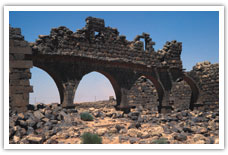
The eastern most of the major northern cities, Umm Al-Jimal is located at the edge of the eastern basalt desert plain, along a secondary road that was close to the junction of several ancient trade routes that linked central Jordan with Syria and Iraq. Among the most interesting structures to visit are the tall barracks with their little chapel, several large churches, numerous open and roofed water cisterns, the outlines of a Roman fort, and the remains of several town gates
Pella (Tabaqit Fahl)
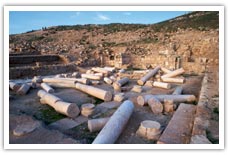
Pella is a favourite of archaeologists as it is exceptionally rich in antiquities, some of which are exceedingly old. Besides the excavated ruins from the Graeco-Roman period, including an Odeon (theatre), Pella offers visitors the opportunity to see the remains of a Chalcolithic settlement from the 4th millennium BC, the remains of Bronze and Iron Age walled cities, Byzantine churches and houses, an Early Islamic residential quarter, and a small medieval mosque.
